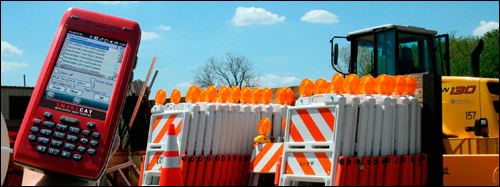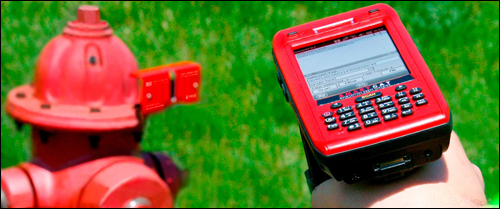Municipalities typically have hundreds of thousands of assets that they must manage and keep in proper working order, including fire hydrants, signs and traffic lights. Government employees are often dispatched twice annually to inspect each unit, record the inspection results and itemize any maintenance work completed during that task. Frequently, workers are equipped with a pen and paper, and information must be manually typed into a computer system at a later date.
The above process is time-consuming and error-prone, however. Therefore, RFID solution provider William Frick & Co. has released a radio frequency identification system to identify items being inspected, and to electronically track the services or maintenance performed on a particular asset for municipalities or utility companies. The SmartCAT Asset Tracking System, released this month, consists of a ruggedized handheld passive ultrahigh-frequency (UHF) RFID reader, software loaded on that device to manage the collected data, and Frick’s SmartMARK UHF RFID tags. Peripheral equipment, such as a USB charging stand, a spare battery and a user guide, are also included.
The handheld comes with a built-in bar-code scanner, a digital camera, GPS functionality and a keypad for inputting data, along with the passive UHF RFID reader. With the solution in place, cities or utility companies can simply attach tags to items they wish to manage and then begin reading those tags, without requiring their IT department to perform software integration.
During the past few years, Frick had found that many potential customers, particularly municipalities, wanted to apply its ruggedized UHF tags to their assets for the purposes of inspection and inventory management. However, the company reports, gaining the necessary approvals for their IT department to integrate the technology with existing software often caused obstacles.
“They found the ROI [return on investment] for use of tags was there, but to implement an RFID system, they had to go back to the IT department,” says John Poplawski, William Frick and Co.’s product-development manager. So Frick—which previously supplied RFID tags, rather than readers—developed a full solution that would be low-cost but not require integration with a user’s own management system.
The technology is currently being tested by a U.S. municipality that has asked to remain unnamed. The use of RFID offers a more efficient and less error-prone solution for data collection, according to David Trebacz, William Frick’s marketing director. Most small or mid-sized municipalities assign personnel equipped with a ledger or a pad of paper to visit hydrants or other assets, write down details and then bring that paperwork to the office, where the asset-managing staff input that information into a spreadsheet or other software. “We wanted to introduce a technology that eliminates the need for paperwork,” Poplawski states.
The ruggedized reader is the first produced by Frick. When a municipality acquires the system, personnel attach an adhesive tag to an asset, such as a hydrant, and use the handheld to read or scan a bar code on that tag. The workers then input any necessary details, such as the specific hydrant’s identifier number or code, along with its maintenance history.
At the time of inspection, an inspector utilizes the handheld—which has a typical read range of 15 feet—to capture the ID number of a hydrant or other object. In some cases, Trebacz says, Frick also provides tags with read ranges of up to about 30 feet. Software on the reader calls up information regarding that item, stored in the handheld’s SmartCAT software. The software also records GPS location data, in order to confirm where that asset is situated. The GPS data can then be used to locate an item in need of maintenance, based on information stored in the handheld’s software.

During inspection, the handheld’s software displays a list of tasks on the screen that the user must complete for that specific asset. The inspector can configure the tasks, and can not only respond to prompts, indicating he or she has completed a particular job, but also input any details, such as the discovery of damage to the item. The user could also utilize the handheld to take a photograph to accompany his or her report. The culled data is stored on the device—which has a storage capacity of up to 250 megabytes—until it is returned to the office, where it can then be docked and all asset data can be uploaded to a computer. What’s more, the system comes with Wi-Fi or Bluetooth capabilities, enabling data to be sent from the device while the inspector is still in the field.
The system can also scan 2D bar codes. Thus, municipalities could begin with bar-code scanning and then transition to radio frequency identification, or use RFID to track high-value assets and bar codes for lower-value items.
For an industrial application, the same solution could be employed to manage rental equipment used on construction sites. In this scenario, a company that rents items—pieces of scaffolding, for instance—could track which units had been rented for which job sites, as well as when they were returned, thereby making it easier to identify if specific assets were not returned when expected. Frick is currently in conversations with such a rental company, regarding its trialing of this solution.
In addition, Poplawski says, hospitals could use the SmartCAT solution to track health-care equipment or patients wearing wristbands with built-in Frick tags. The technology also works with any other EPC UHF RFID tag, he notes.
A kit providing a handheld reader and software costs $5,750. With 26 durable tags included, the price is $5875, but Frick is presently offering a coupon for a free tag starter kit for anyone who purchases the reader and software. The solution comes with a three-year warrantee.


